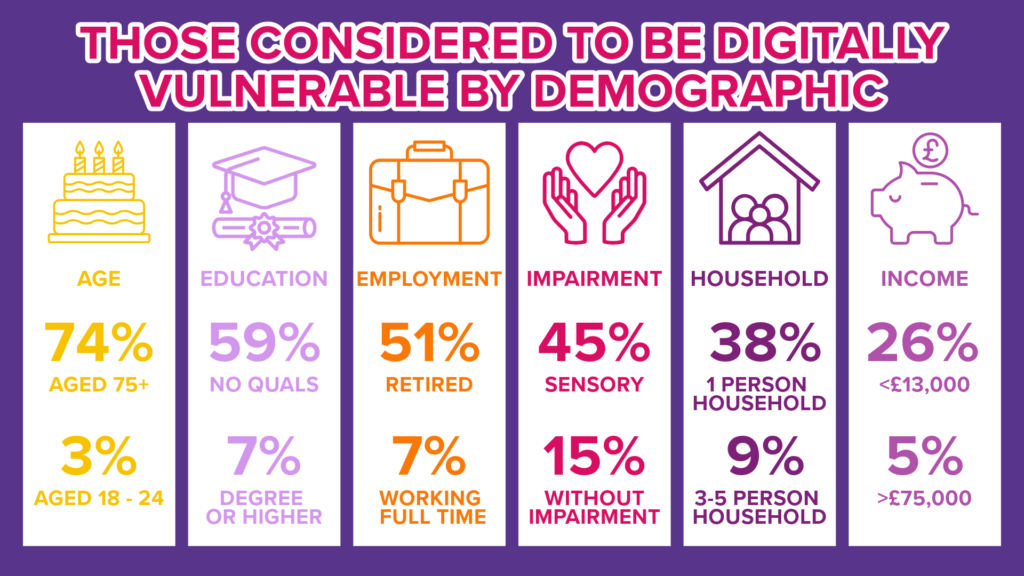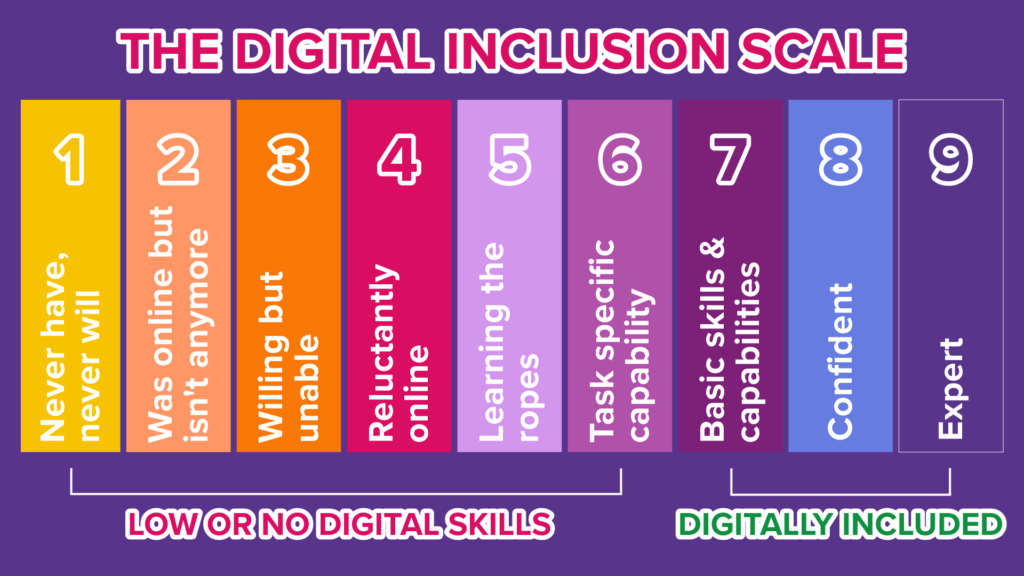In an increasingly digital world, market research has embraced online platforms for their efficiency and reach. However, this reliance introduces a critical consideration – digital vulnerability. Not everyone possesses equal access or capability when it comes to technology. This disparity can lead to skewed data, bias and the exclusion of crucial demographics.
At BEAM we specialise in working with vulnerable audiences. We believe that awareness of the impact of digital disadvantage and vulnerability is essential to ensure accurate and fair research that truly represents the UK population. Understanding these vulnerabilities is key to ensuring inclusive and effective recruitment that will produce reliable market insights.
The first port of call is understanding the difference between those that are digitally disadvantaged and those that are digitally excluded. While they are similar, there are fundamental differences.
Digitally disadvantaged – in which a person or group of people receive different more harmful experiences of digital services when compared to others. This overarching term includes experiences of digital exclusion and those with low or no digital skills.
Digitally excluded – a significant and enduring lack of access to the internet. This includes experiences linked to a lack of access in the home, a lack of access or having no digital skills.
Digital vulnerabilities effect a huge part of the UK population. Only 3% of 18-24 experience digital vulnerabilities, which skyrockets to 74% of those aged 75+. 93% of people who experience digital inclusion work full time and have a degree or higher level of education, where are only 41% of those without qualifications have digital access, along with 49% of those who are retired. Only 5% of people earning more than £75,000 a year are digitally vulnerable in comparison to 26% of those earning less than £13,000 a year. 91% of people in a 3-to-5-person household have digital access, which reduces significantly to 62% in 1 person households. Finally, 45% of people with a sensory impairment are considered to be digitally vulnerable in comparison to 15% of people without an impairment.

More inclusive approaches
We asked Ffion, Account Manager on our Specialist Team, her thoughts on how to include digitally vulnerable participants in market research –
‘With digital and online solutions becoming so common place in market research approaches, it is increasingly easy to exclude digitally vulnerable people, who could otherwise thrive in market research sessions and can provide helpful and in-depth perspectives and most importantly fully representative outcomes.
There are many relatively easy ways to include the digitally vulnerable into market research activity. However, these approaches often take longer to implement and with speed often being a priority, longer fieldwork and recruitment processes that help to identify and onboard these individuals aren’t an option. Offering more traditional recruitment and research session practices can make a big difference. Sometimes traditional approaches work best, and I advise that a PM should always be available for a phone call in these types of projects, as you are usually the spokesperson for that respondent or for the client and vice versa.
When working on a project where perspectives were needed from older people, we placed recruiters/interviewers in-store (or in-bank as was the case here) recruiting those who were interested, providing them with leaflets and information packs around the research sessions that were happening a few days later. A follow-up call for a screener-type discussions was made to ensure they understood everything, and to ensure the potential respondent could ask questions. This approach led to these people being successfully recruited to the research.
When considering participants with disabilities, offering additional layers of support are imperative to ensure people can engage with the research in much the same way as those who do not have disabilities. For example, screen readers for image displays for those who are blind or have vision loss, or sending session prompts ahead of time to those with processing difficulties. Further-more, carer-patient and friendship paired depths could also allow a more comfortable atmosphere for those who do not feel comfortable navigating sessions on their own. In the past we have facilitated carers attending sessions to aid a participant in accessing a Zoom call. The carer acted as a go between where necessary, receiving all relevant information, but did not interact in place of that participant.
Essentially, there is no reason why market research cannot be adapted to ensure realistic and effective representation. With adaptable approaches, open mindedness and an appreciation of a slightly slower pace exclusion of a significant number of people can be prevented.’
Learn more about Ffion and her PhD here
The digital inclusion scale
Ensuring that we are able to effectively support those who are digitally vulnerable starts with understanding the spectrum of digital experience and access. The following is a scale that helps to identify people’s needs and what is realistic within their experience.

1 Never have, never will
‘I’ve survived this long without it, so I don’t see why I would need it in the future’
- Predominantly includes older people or people who were born before digital technology become commonplace.
- May feel they have missed the boat and that learning how to use the internet doesn’t fit in to their lives.
- Often have negative perceptions of the internet.
Stats in this category –
- 88% are aged 45 or over
- 61% are from socio-economic groups D and E
- Most are single with no family at home
- Largely that are satisfied with their lives as they are
This group needs varying degrees of help to get online for reasons such as personal attitudes, low motivation, low confidence in their digital skills, physical or cognitive impairments.
2. Was online, no longer online
‘I used to be online, but I don’t like it/trust it and I’m not confident. Someone else does it for me.’
- May have lost trust in the internet
- Afraid of fraud or seeing inappropriate things
- May have lost internet access due to cost
- May have a physical or mental capacity
Stats in this category –
- Mostly aged 65 – 75
- Make up 3% of UK population
- 61% are from socio-economic groups D and E
- 90% have someone to do online transactions for them
This group has varying degrees of digital skills and need a light touch approach like refresher training and need to concentrate on learning a particular skill that’s essential.
3. Willing but unable
‘I wish I could learn but I don’t feel I have the confidence or skills, and I might make a fool of myself.’
- Mostly ‘empty nesters’ or late in their working lives
- May struggle to learn new skills
- May have low literacy and/or language skills
- Cost of access may pose a barrier
Stats in this category –
- Small majority identify as female, with a slightly lower number of males
- 83% are aged 45 or older
- 58% are in socio-economic groups D and E
This group has a positive perception of being online but have problems with a lack of access to the internet, self-confidence and skills to navigate the online world.
4. Reluctantly online
I’m online because there’s no other option and I lose out if I don’t. I’m resentful and find it difficult.’
- May be resentful of the internet due to being forced to learn something they find hard
- Struggle to learn new computer or internet skills
- Believes most things are not easy to complete online e.g. job seeker’s allowance
- Understands the benefits of being online but have yet to experience them personally
Stats in this category –
- 50% are ages 24 to 44
- 51% are in socio-economic groups C1 and C2
- 70% have children at home and use the family computer
This group are wary of the world online because they are not fully independent online and still need help or support, many do not want their personal information to be online and feel it’s intrusive, and their children know more than they do.
5. Learning the ropes
‘I’m learning how to do things myself but still need some help. I’m growing in confidence.’
- Predominantly positive about the benefits of the internet
- Willing started to engage with digital technologies
- Still need help when they use digital services as they develop digital skills
Stats in this category –
- Small majority identify as female with a slightly lower number of males
- 9% are aged 16 to 44
- 41% are in socio-economic groups C2, D and E
This group often are or were stay-at-home mums or manual workers with younger families.
6. Task specific
‘I only go online to do specific jobs I’m confident with like checking my bank account or updating social media.’
- Have the capability and access but need to be encourage
- Need to develop their confidence to learn new tasks
- May struggle to gain regular access to the internet and online services
- Could be shown how to access and engage with a wider set of digital services
The tasks that this group complete online are –
- Limited and specific
- Habitual and regular
- Seen as being essential to everyday life
This group tend not to have regular contact with computers in work and may be manual workers, long-term unemployed or retired.
7. Basic digital skills and capabilities
‘I have the skills to be everyday online things myself like fill out application forms, appraise a website’s trustworthiness, make a purchase and use a search engine.’
- Have enough skills to be able to navigate online independently
- Can perform all tasks at a basic level
- May need some help with new tasks
- Tend not to need ongoing support after initial training
This group are able to –
- Send and receive emails and identify and delete spam
- Use a search engine and browse the internet and evaluate which websites to trust
- Fill out an online application, make a booking or purchase, access government services, create a social profile and manage privacy settings
8. Confident
‘I have no problems with using everyday new technologies and exploring online services.’
- Confident users of digital tools at work and in their everyday lives
- If they become stuck, they can confidently search for the relevant help online and identify someone with the right level of expertise to help
9. Expert
‘I’ve got advanced digital skills, have knowledge of technical processes in computer systems and how the online world works.’
- Tend to be highly skilled across a wide range of digital skillsets
- Often have specialist knowledge of the underlying technical processes
- Online and digital capability would be considered to be advanced
Stats in this category –
- Most likely to be male
- Least likely to have families
- 48% are aged 16 to 34
- 57% are in socio-economic groups A, B and C1
If you’d like to know more about adapting your projects to ensure the digitally vulnerable are included, or to know more about how BEAM specialise in working with vulnerable audiences, get in touch. Drop us a line here
